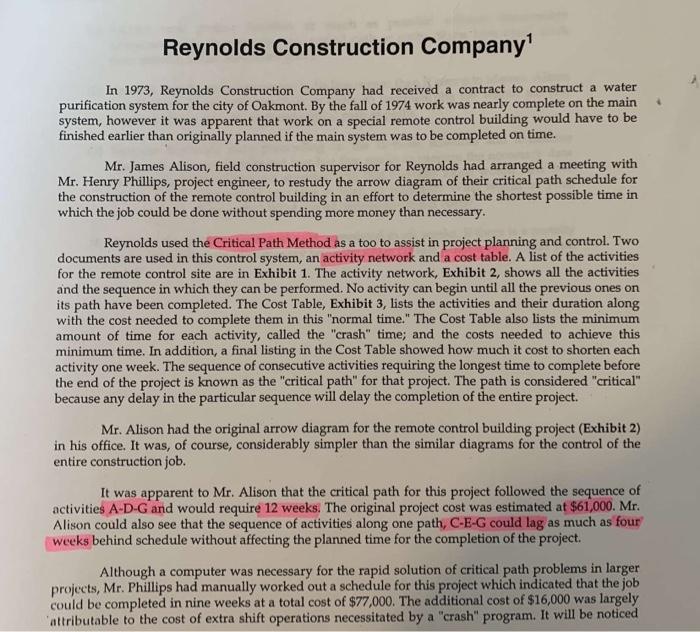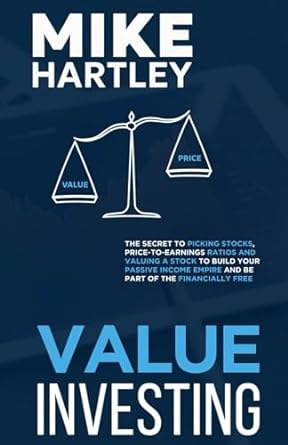Reynolds Construction Company In 1973, Reynolds Construction Company had received a contract to construct a water purification system for the city of Oakmont. By the fall of 1974 work was nearly complete on the main system, however it was apparent that work on a special remote control building would have to be finished earlier than originally planned if the main system was to be completed on time. Mr. James Alison, field construction supervisor for Reynolds had arranged a meeting with Mr. Henry Phillips, project engineer, to restudy the arrow diagram of their critical path schedule for the construction of the remote control building in an effort to determine the shortest possible time in which the job could be done without spending more money than necessary. Reynolds used the Critical Path Method as a too to assist in project planning and control. Two documents are used in this control system, an activity network and a cost table. A list of the activities for the remote control site are in Exhibit 1. The activity network, Exhibit 2, shows all the activities and the sequence in which they can be performed. No activity can begin until all the previous ones on its path have been completed. The Cost Table, Exhibit 3, lists the activities and their duration along with the cost needed to complete them in this "normal time." The Cost Table also lists the minimum amount of time for each activity, called the "crash" time; and the costs needed to achieve this minimum time. In addition, a final listing in the Cost Table showed how much it cost to shorten each activity one week. The sequence of consecutive activities requiring the longest time to complete before the end of the project is known as the "critical path" for that project. The path is considered "critical" because any delay in the particular sequence will delay the completion of the entire project. Mr. Alison had the original arrow diagram for the remote control building project (Exhibit 2) in his office. It was, of course, considerably simpler than the similar diagrams for the control of the entire construction job. It was apparent to Mr. Alison that the critical path for this project followed the sequence of activities A-D-G and would require 12 weeks. The original project cost was estimated at $61,000. Mr. Alison could also see that the sequence of activities along one path, C-E-G could lag as much as four weeks behind schedule without affecting the planned time for the completion of the project. Although a computer was necessary for the rapid solution of critical path problems in larger projects, Mr. Phillips had manually worked out a schedule for this project which indicated that the job could be completed in nine weeks at a total cost of $77,000. The additional cost of $16,000 was largely "attributable to the cost of extra shift operations necessitated by a "erash" program. It will be noticed that in his revised schedule (Exhibit 4), three paths had become critical to the completion of the project as rescheduled. Questions: (1) Reduce total project duration as much as possible without unnecessary additional costs. Indicate the new critical path or paths. Show how much slack time remains in the noncritical paths. (2) Assume that the situation proves to be less urgent than it seems to Messrs. Alison and Phillips. Revise the schedule in order to complete the job within ten (10) weeks. Indicate the new cost and critical path or paths. (3) Suppose Reynolds were proceeding on the 10-week schedule and it became obvious that it would take not two but five weeks to prepare the necessary data for the request for Oakmont approval and that this step alone would now cost $7,000. What steps would you take to keep on schedule? What would be your new critical path or paths? What would happen to project costs? Reynolds Construction Company In 1973, Reynolds Construction Company had received a contract to construct a water purification system for the city of Oakmont. By the fall of 1974 work was nearly complete on the main system, however it was apparent that work on a special remote control building would have to be finished earlier than originally planned if the main system was to be completed on time. Mr. James Alison, field construction supervisor for Reynolds had arranged a meeting with Mr. Henry Phillips, project engineer, to restudy the arrow diagram of their critical path schedule for the construction of the remote control building in an effort to determine the shortest possible time in which the job could be done without spending more money than necessary. Reynolds used the Critical Path Method as a too to assist in project planning and control. Two documents are used in this control system, an activity network and a cost table. A list of the activities for the remote control site are in Exhibit 1. The activity network, Exhibit 2, shows all the activities and the sequence in which they can be performed. No activity can begin until all the previous ones on its path have been completed. The Cost Table, Exhibit 3, lists the activities and their duration along with the cost needed to complete them in this "normal time." The Cost Table also lists the minimum amount of time for each activity, called the "crash" time; and the costs needed to achieve this minimum time. In addition, a final listing in the Cost Table showed how much it cost to shorten each activity one week. The sequence of consecutive activities requiring the longest time to complete before the end of the project is known as the "critical path" for that project. The path is considered "critical" because any delay in the particular sequence will delay the completion of the entire project. Mr. Alison had the original arrow diagram for the remote control building project (Exhibit 2) in his office. It was, of course, considerably simpler than the similar diagrams for the control of the entire construction job. It was apparent to Mr. Alison that the critical path for this project followed the sequence of activities A-D-G and would require 12 weeks. The original project cost was estimated at $61,000. Mr. Alison could also see that the sequence of activities along one path, C-E-G could lag as much as four weeks behind schedule without affecting the planned time for the completion of the project. Although a computer was necessary for the rapid solution of critical path problems in larger projects, Mr. Phillips had manually worked out a schedule for this project which indicated that the job could be completed in nine weeks at a total cost of $77,000. The additional cost of $16,000 was largely "attributable to the cost of extra shift operations necessitated by a "erash" program. It will be noticed that in his revised schedule (Exhibit 4), three paths had become critical to the completion of the project as rescheduled. Questions: (1) Reduce total project duration as much as possible without unnecessary additional costs. Indicate the new critical path or paths. Show how much slack time remains in the noncritical paths. (2) Assume that the situation proves to be less urgent than it seems to Messrs. Alison and Phillips. Revise the schedule in order to complete the job within ten (10) weeks. Indicate the new cost and critical path or paths. (3) Suppose Reynolds were proceeding on the 10-week schedule and it became obvious that it would take not two but five weeks to prepare the necessary data for the request for Oakmont approval and that this step alone would now cost $7,000. What steps would you take to keep on schedule? What would be your new critical path or paths? What would happen to project costs








